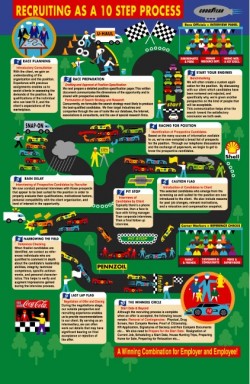There is no denying that the economy is on the rebound, and we are seeing growth across many industries that is unprecedented in the last decade. As consumers become more comfortable with loosening their purse strings, companies are able to focus on growth instead of simply maintaining the status quo. Businesses are daring to expand into new ventures, and hiring freezes are finally being lifted.
 Just because you can hire, however, does not always mean that you should. How do you know when the time is right to hire more employees? Keeping the correct balance between the amount of work and available staff can be difficult; even with the economy steadily improving, industries continue to experience natural highs and lows in demand. Some companies tend to hire unnecessarily, wasting thousands of dollars in the process when they would be better served by a short-term fix; they may hire and train new employees during a rush, only to have to turn around a few months later and conduct layoffs during an easily-foreseeable slump. Others may miss profitable opportunities because they don’t have adequate staff or the right kind of talent to handle new projects.
Just because you can hire, however, does not always mean that you should. How do you know when the time is right to hire more employees? Keeping the correct balance between the amount of work and available staff can be difficult; even with the economy steadily improving, industries continue to experience natural highs and lows in demand. Some companies tend to hire unnecessarily, wasting thousands of dollars in the process when they would be better served by a short-term fix; they may hire and train new employees during a rush, only to have to turn around a few months later and conduct layoffs during an easily-foreseeable slump. Others may miss profitable opportunities because they don’t have adequate staff or the right kind of talent to handle new projects.
How can a manager assess the staffing situation and make an informed decision about whether or not (s)he needs to hire? There are several factors that need to be taken into consideration; here are several tips that will help you decide if you need to add to your workforce.
(In)Ability to Meet Deadlines
How many times have you had to extend deadlines in the past few months in order to meet customer orders? If the answer is weekly, or even daily, then you need to take a closer look at why. Although many factors can influence whether or not a product is delivered (or a project is completed) on time, the most obvious answer is lack of people. When staffing levels are not adequate, projects get extended, staff gets involved in non-primary tasks, and the real business of production gets delayed. If you are experiencing an increase in missed deadlines, then you may need to staff up in order to meet commitments.
Employee Wellness
How often are your employees calling in sick or filing health insurance claims? Most employees are exposed to some level of stress in their jobs. However, understaffing can result in stress building to such levels that it leads to more serious health conditions. If you notice an increase in sick time, or an increase in the number of employees that have taken a leave of absence because of stress-related illnesses, chances are your staff may be overworked.
On the opposite end of the spectrum, employees who choose to carryover – or even forfeit! – their vacation time may be doing so because they are feeling the pressure. In most companies, employees are left to determine how and when to use their time off. However, when an individual feels like they have too much to do to take any time off, or feels that no one else is competent to cover their work for them should they choose to take time off, inadequate staffing levels could be to blame.
Overtime Costs
Another cue that offers some insight into whether or not you are understaffed is overtime costs. Have they increased significantly over the past few months? Are they considerably higher than forecasted? If so, chances are there is simply not enough staff to get the job done in a sufficient amount of time.
Overtime can cost companies billions of dollars per year. One way to reduce that cost, while making sure that you are able to meet production goals, is to hire more people. By bringing fresh talent on board, you may also improve quality that may have been comprised by overworked, overtired staff.
Time Logs
Consider asking your staff to track their activities in a daily time log. Although the notion may not go over well initially, they will soon find that it takes a minimal time investment on their part, and is a very worthwhile way to spend a few extra minutes. Time logs provide a very precise way of determining how each member of your staff is spending his or her time. You’ll be able to evaluate how much time is dedicated to critical “A” tasks, versus how much time is spent on non-critical or “B” tasks. A time log may also bring to light certain areas in which employees are working that are not generally covered in their job descriptions. For example, if your R&D professionals are spending an inordinate amount of time trying to resolve technical issues with their programs, you may decide that hiring an IT support person for their department will save you money in the long-run.
A number of online time tracking logs are now available to companies for a small fee that provide specialized reports that breakdown a staff’s time by department, project, or even by individual.

Lack of Talent
Have you had to “pass” on potential business opportunities because you lack the right talent on your staff to handle the task? Maybe you don’t have time to cultivate a promising new business relationship because all of your sales people already have their hands full with key accounts. The chemical, pharmaceutical, and allied industries are rapidly evolving businesses. In order to stay on top of new trends in the market, companies have to constantly inventory their staff in order to ensure they can handle whatever opportunities come their way. If you don’t have enough people (or people with the right skills), you risk losing a competitive edge. Smart companies avoid this pitfall by staying on top of the talent market, by knowing who is available, and which skills and traits are in demand. That way, when a growth opportunity presents itself, you will know where to find the people you need to succeed.
Use of Temporary Employees
How often are you utilizing temporary or contract workers? Are you consistently contracting them in the same departments for the same positions? Contract staffing can, at certain times, be a smart move strategically for a company. However, when you repetitively require the same “temporary” personnel for tasks and keep them on board for more than six months at a time, it may be an indication that there is a more permanent need. You should also consider that each time a contract staffer is brought on to do work, there is a lag in productivity in order to accommodate the learning curve. Making a permanent hire will eliminate that gap and ensure a more productive pace.
Room for Improvement
Does your management team dedicate time to generating new ways to improve the workflow process and give constructive ideas for staff improvement? If so, is it difficult to get the staff to accept and incorporate the process improvements into their daily work?
In order to keep a competitive edge, organizations need to periodically re-evaluate their methodologies and make the necessary adjustments to ensure they are functioning at peak performance levels. When new ideas are suggested but implementation of those ideas fails, a lack of time or energy is often to blame. Employees who are overworked have to focus their time on simply covering everyday duties, and don’t always have the ability or interest to focus on improvement. Conversely, when a department is staffed at appropriate levels, it allows a little “breathing room” for employees to go above and beyond their routine tasks and dedicate some time to upgrading their practices.
Thinking Ahead
When determining whether you have current hiring needs, you need to look beyond your current situation. If you are anticipating growth – from a new product launch, a massive marketing campaign, etc. – you will want to assess whether it makes sense for you to bring in additional staff to pick up the slack. Be careful in considering whether that expected growth will be permanent, or whether the rush will only last for a limited time; use these predictions to determine how many temporary and how many full-time staff you will want to hire. Be sure not to wait until the last minute – bringing on new staff as the growth is occurring isn’t good enough. They need to have time for proper training if they are going to be effective.
Succession planning is another important area of consideration. People are going to leave their jobs eventually, whether it’s to take a position of increased responsibility within your company, to accept a job with another company>, or for retirement. Make sure you have a plan in place to deal with these eventualities. One strong tactic is to have predetermined ideas of which employees could/would move up to fill certain key positions when they become available. This serves two purposes: it gives you a plan for the future, and its implementation demonstrates the capacity for career growth that your company offers. This latter will ensure your employees are willing to stay with your company longer (after all, most attrition is a result of employees wanting to take the next step on the career ladder), and will also help you to attract high-performing, loyal talent.
Staff for Success
 Making the decision to hire more employees for your staff should not be made without taking a full-scale evaluation of your current situation. If you are lacking in several of the areas discussed in this column, chances are you may be understaffed. An appropriate level of staffing takes into consideration the well being of your current employees in order to avoid burnout, and the ability of your company to succeed. By staying in tune with the changing needs of your company you will have a better understanding of when the time is right to hire.
Making the decision to hire more employees for your staff should not be made without taking a full-scale evaluation of your current situation. If you are lacking in several of the areas discussed in this column, chances are you may be understaffed. An appropriate level of staffing takes into consideration the well being of your current employees in order to avoid burnout, and the ability of your company to succeed. By staying in tune with the changing needs of your company you will have a better understanding of when the time is right to hire.



